Chemists find new way of creating the building blocks of many drugs

Organic chemists at The Ohio State University have figured out how to synthesize the most common molecule arrangement in medicine, a scientific discovery that could change the way a number of drugs—including one most commonly used to treat ovarian cancer—are produced.
Their discovery, published today in the journal Chem, gives drug makers a crucial building block for creating medicines that, so far, are made with complex processes that result in a lot of waste.
This new finding may allow drug makers to create this building block in just one step, said David Nagib, the study's senior author and assistant professor in the Department of Chemistry and Biochemistry at Ohio State.
A drug's molecules must interact in just the right way with the molecules inside the human body to be effective. It's like when two people meet: Each person must use their right hand to shake hands with each other. If one person tries to use their left hand, it just doesn't work.
"Another way to look at it is that drugs work like a lock and key, and you have to put a left-handed key into a left-handed lock," Nagib said.
The most common arrangement of molecules used in drugs so they can interact effectively with human molecules is called a chiral piperidine.
Currently, drug makers synthesize this molecule arrangement using a circuitous process that involves creating a mixture and essentially throwing half that mixture out.
"Previously, there was no available method that simply swapped a single carbon-hydrogen bond for a carbon-carbon bond like this," said Zuxiao Zhang, the study's lead author and a postdoctoral researcher in Nagib's lab. "And what we figured out is, through free radicals, we can make this happen."
The heart of their discovery lies in the chemical bonds that make up a molecule. The researchers considered a number of drugs and looked at the way their molecules are created. One, the anti-cancer drug niraparib—a pill used to treat ovarian cancer—uses a chiral piperidine. But to produce it, the drug's makers have to create a number of symmetric mixtures, then strip parts away until they get to the asymmetric molecule necessary to make the drug effective.
Creating that chiral six-sided ring synthetically was a problem that had troubled chemists for decades. It was so tricky, in fact, that when Zhang first approached Nagib about tackling it, Nagib was unsure it was the right problem to solve.
"The success of this chemistry was entirely thanks to Zuxiao's courage and ambition to tackle such a hard problem," Nagib said.
It is a fundamental change that Nagib hopes might make a number of medicines easier to produce.
"It's a different way of doing things," he said. "It's like flying an airplane over the Atlantic. Is that a shortcut, instead of having a boat? Yes, it's a more efficient way of going, but it's also a fundamentally different way. If you fly across the Atlantic, now you can do other things—you can fly other places. That's what this."
Journal information: Chem
Provided by The Ohio State University



















